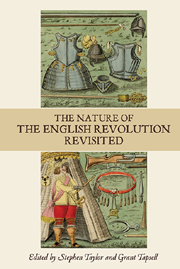Book contents
- Frontmatter
- Contents
- Preface and Acknowledgements
- List of contributors
- List of Abbreviations
- 1 Charles I and Public Opinion on the Eve of the English Civil War
- 2 Rethinking Moderation in the English Revolution: The Case of An Apologeticall Narration
- 3 The Parish and the Poor in the English Revolution
- 4 Body Politics in the English Revolution
- 5 The franchise Debate Revisited: The Levellers and the Army
- 6 Oliver Cromwell and the Instrument of government
- 7 ‘de te fabula narratur’: The Narrative Constitutionalism of James Harrington's Oceana
- 8 Democracy in 1659: Harrington and the Good Old Cause
- 9 The Restoration of the Church of England, 1660–1662: Ordination, Re-ordination and Conformity
- 10 Style, Wit and Religion in Restoration England
- 11 A British Patriarchy? Ecclesiastical Imperialism under the Later Stuarts
- Index
- Studies in Early Modern Cultural, Political and Social History
4 - Body Politics in the English Revolution
Published online by Cambridge University Press: 05 July 2013
- Frontmatter
- Contents
- Preface and Acknowledgements
- List of contributors
- List of Abbreviations
- 1 Charles I and Public Opinion on the Eve of the English Civil War
- 2 Rethinking Moderation in the English Revolution: The Case of An Apologeticall Narration
- 3 The Parish and the Poor in the English Revolution
- 4 Body Politics in the English Revolution
- 5 The franchise Debate Revisited: The Levellers and the Army
- 6 Oliver Cromwell and the Instrument of government
- 7 ‘de te fabula narratur’: The Narrative Constitutionalism of James Harrington's Oceana
- 8 Democracy in 1659: Harrington and the Good Old Cause
- 9 The Restoration of the Church of England, 1660–1662: Ordination, Re-ordination and Conformity
- 10 Style, Wit and Religion in Restoration England
- 11 A British Patriarchy? Ecclesiastical Imperialism under the Later Stuarts
- Index
- Studies in Early Modern Cultural, Political and Social History
Summary
In early 1641, the fall of the king's leading minister, the earl of Strafford, dominated the news. Unsurprisingly, Strafford's fate was widely discussed by the writers of letters and pamphlets. But in reporting his trial and execution, a surprising amount of attention was paid to the gestures that marked Strafford's passage from trial to execution. According to one account, both at his appearance and departure from the Tower, Strafford returned the crowds' salutes, ‘with great humility and courtesie’. But the Scot Robert Baillie reported that at his departure that day this gesture was not reciprocated: there was ‘no man capping him before whom this morning the greatest of all England would have stood dis-covered’. Brought to the bar of the house of lords Strafford, whose own demands as Lord Deputy in Ireland that the king's officers there kneel to him had provoked criticism, was forced to kneel as a delinquent. During the trial, it was noted that when the king attended he removed his hat deferentially to Strafford as a public mark of his support and that subsequently he sent word that as a favour Strafford should be allowed to sit during his trial. Nevertheless, at key points in the trial Strafford fell to his knees, on one occasion after making ‘3 low congees to ye lords’ as an elaborate acknowledgment of their legitimacy; at another key point of controversy over evidence kneeling and ‘humbly craving pardon’.
- Type
- Chapter
- Information
- The Nature of the English Revolution Revisited , pp. 81 - 102Publisher: Boydell & BrewerPrint publication year: 2013



